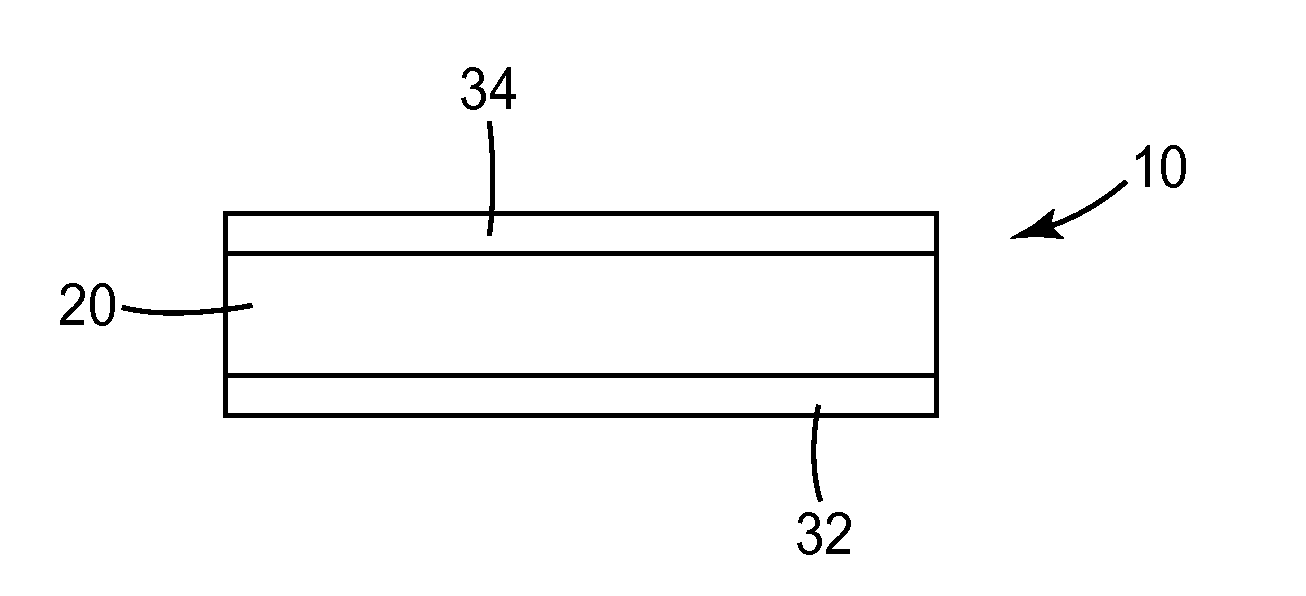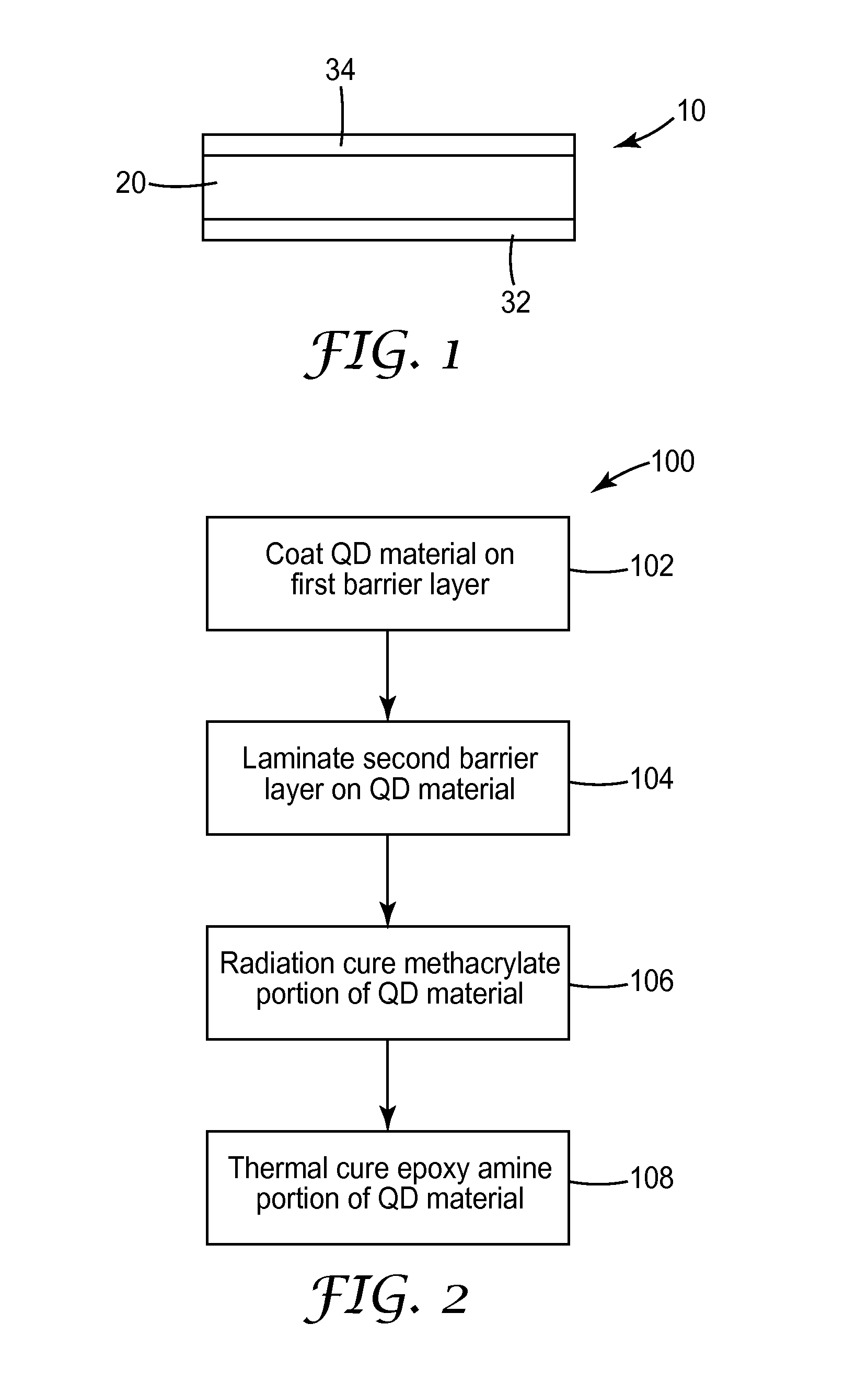Quantum dot film
- Summary
- Abstract
- Description
- Claims
- Application Information
AI Technical Summary
Benefits of technology
Problems solved by technology
Method used
Image
Examples
example 1
[0039]Two types of solutions were prepared, one according to the current invention and one a control.
[0040]The components and amounts of the control solution, Solution A, are shown in Table 1. The control solution was thus an epoxy-only formulation. Epon 828 was a general purpose epoxy resin available from Momentive Specialty Chemicals (Columbus, Ohio). Part B was Epic RMX91B, a difuntional amine curative, (available from Epic Resins, Palmyra, Wis.) with a 15% white quantum dot concentrate (available from Nanosys Corp., Palo Alto, Calif.) which results in a final quantum dot concentration of 0.1 to 1 wt % in the cured epoxy quantum dot layer.
[0041]The components of Solution B, a hybrid epoxy / methacrylate formulation, are shown in Table 2. Three different versions of Solution B were prepared, each with a different methacrylate. The chosen methacrylates were SR348, SR540, and SR239, all from Sartomer USA, LLC (Exton, Pa.). Epon 824 was an epoxy resin available from Momentive Specialty...
example 2
[0045]Control Solution A was prepared as in Example 1. Solutions B through G were prepared as with the methacrylate solutions of Example 1 except that the methacrylate used was SR348 at six different levels ranging from 5% to 30% by weight. Components of all solutions are shown in Table 5.
TABLE 5Solution ASolution BSolution CSolution DSolution ESolution FSolution G% 0% 14% 30% 25% 20% 10% 5%MethacrylateSR348SR348SR348SR348SR348SR348SR348Epon 82465.0%55.6%45.2%48.4%51.7%58.2%61.4%SR34814.0%30.0%25.0%20.0%10.0%5.00%Darocur0.50%0.50%0.50%0.50%0.50%0.50%4265Part B35.0%29.9%24.3%26.1%27.8%31.3%33.1%Total100.0% 100.0% 100.0% 100.0% 100.0% 100.0% 100.0%
[0046]The above solutions were mixed and coated between two 2 mil silicon release liners at a thickness of 50 micrometers with a knife coater as before, then UV and thermally cured as in Example 1. Water vapor transmission rates were measured as in Example 1. Results are shown in Table 6. Water vapor transmission properties were rela...
example 3
[0047]Two solutions were prepared to compare the peel strength performance of films with and without quantum dots.
[0048]Solution J was prepared with the proportions described in Table 7 below and was similar to previous formulations. Solution B was similar except that the Part B component was Epic RMX91B without the quantum dot concentrate The components of each solution are shown in Table 7. The two solutions were coated at 20 feet per minute on a pilot coater using a slot fed die with ¼ inch face and rear feed. Part A consisted of DER362 (diepoxy from Dow Chemical, Midland, Mich.), SR348 and Darocur 4265 and was fed via one pressure pot under nitrogen and Part B (the Epic RMX91B with or without quantum dots) was fed by another pressure pot, also under nitrogen. The two parts were fed into a static mixer before feeding into the die. The ratio of Part A to Part B was 2.3 to 1. Each solution was coated onto a 2 mil barrier film (previously described) and then immediately laminated to...
PUM
| Property | Measurement | Unit |
|---|---|---|
| Viscosity | aaaaa | aaaaa |
| Viscosity | aaaaa | aaaaa |
| Size | aaaaa | aaaaa |
Abstract
Description
Claims
Application Information
 Login to View More
Login to View More - R&D
- Intellectual Property
- Life Sciences
- Materials
- Tech Scout
- Unparalleled Data Quality
- Higher Quality Content
- 60% Fewer Hallucinations
Browse by: Latest US Patents, China's latest patents, Technical Efficacy Thesaurus, Application Domain, Technology Topic, Popular Technical Reports.
© 2025 PatSnap. All rights reserved.Legal|Privacy policy|Modern Slavery Act Transparency Statement|Sitemap|About US| Contact US: help@patsnap.com


